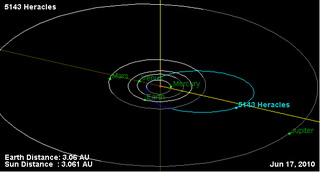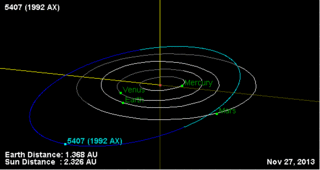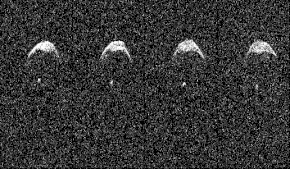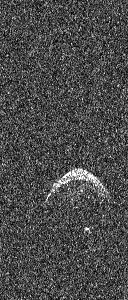
1620 Geographos, provisional designation 1951 RA, is a highly elongated, stony asteroid, near-Earth object and potentially hazardous asteroid of the Apollo group, with a mean-diameter of approximately 2.5 km (1.6 mi). It was discovered on 14 September 1951, by astronomers Albert George Wilson and Rudolph Minkowski at the Palomar Observatory in California, United States. The asteroid was named in honor of the National Geographic Society.

4183 Cuno, provisional designation 1959 LM, is an eccentric, rare-type asteroid, classified as near-Earth object and potentially hazardous asteroid of the Apollo group, and measures approximately 4 kilometers in diameter.
4486 Mithra, is an eccentric asteroid and suspected contact-binary, classified as near-Earth object and potentially hazardous asteroid, approximately 2 kilometers in diameter. It belongs to the Apollo group of asteroids and is a relatively slow rotator.
1866 Sisyphus is a binary stony asteroid, near-Earth object and the largest member of the Apollo group, approximately 7 kilometers in diameter.
5653 Camarillo ( KAM-ə-REE-oh), provisional designation 1992 WD5, is a stony asteroid and near-Earth object of the Amor group, approximately 1.5 kilometers in diameter.

5143 Heracles, provisional designation 1991 VL, is a highly eccentric, rare-type asteroid and synchronous binary system, classified as near-Earth object of the Apollo group, approximately 4.8 kilometers in diameter. The asteroid was discovered on 7 November 1991, by American astronomer Carolyn Shoemaker at Palomar Observatory in California, United States. It is named for the Greek divine hero Heracles. It has an Earth minimum orbit intersection distance of 0.058 AU (8.7 million km) and is associated with the Beta Taurids daytime meteor shower.
7088 Ishtar, provisional designation 1992 AA, is a synchronous binary asteroid and near-Earth object from the Amor group, approximately 1.3 kilometers in diameter. It was discovered on 1 January 1992, by American astronomer Carolyn Shoemaker at the Palomar Observatory in California. The relatively bright asteroid with an unknown spectral type has a rotation period of 2.7 hours. In December 2005, a 330-meter sized satellite was discovered, orbiting its primary every 20.65 hours.
4055 Magellan, provisional designation 1985 DO2, is a bright and eccentric asteroid and near-Earth object of the Amor group, approximately 2.5 kilometers in diameter. It was discovered on 24 February 1985, by American astronomer Eleanor Helin at Palomar Observatory in California, United States. It was later named for Portuguese explorer Ferdinand Magellan.
11066 Sigurd, provisional designation 1992 CC1, is a stony, rare-type asteroid and elongated contact binary, classified as near-Earth object of the Apollo group of asteroids, approximately 2.5 kilometers in diameter.

1980 Tezcatlipoca, provisional designation 1950 LA, is an eccentric, stony asteroid and near-Earth object of the Amor group, approximately 6 kilometers (4 mi) in diameter.
12923 Zephyr (prov. designation:1999 GK4) is a stony asteroid, classified as potentially hazardous asteroid and near-Earth object of the Apollo group, approximately 2 kilometers (1.2 miles) in diameter. It was discovered on 11 April 1999, by astronomers of the Lowell Observatory Near-Earth Object Search at Anderson Mesa Station near Flagstaff, Arizona. The asteroid was named after the deity Zephyrus from Greek mythology.

(5407) 1992 AX, provisional designation 1992 AX, is a stony asteroid and a synchronous binary Mars-crosser from the innermost region of the asteroid belt, approximately 3.6 kilometers in diameter. It was discovered on 4 January 1992, by Japanese astronomers Seiji Ueda and Hiroshi Kaneda at the Kushiro Observatory on Hokkaidō, Japan. The S-type asteroid has a short rotation period of 2.5 hours. Its sub-kilometer satellite was discovered in 1997. As of 2018, the binary system has not been named.
(5645) 1990 SP is an eccentric and tumbling asteroid, classified as near-Earth object of the Apollo group, approximately 1.7 kilometers in diameter. It was discovered on 20 September 1990, by Scottish–Australian astronomer Robert McNaught at the Siding Spring Observatory in Canberra, Australia. Scientists have said that it has a '1 in 364 billion chance' of colliding with the Earth.
(5646) 1990 TR is a probable rare-type binary asteroid classified as near-Earth object of the Amor group, approximately 2.3 kilometers in diameter. It was discovered on 11 October 1990, by Japanese astronomers Seiji Ueda and Hiroshi Kaneda at Kushiro Observatory near Kushiro, in eastern Hokkaido, Japan.
(7025) 1993 QA is a sub-kilometer asteroid classified as near-Earth object of the Apollo and Amor group, respectively. It was discovered on 16 August 1993, by astronomers of the Spacewatch program at the Kitt Peak National Observatory near Tucson, Arizona, United States. The asteroid measures approximately half a kilometer in diameter and has a short rotation period of 2.5057 hours.
21088 Chelyabinsk, provisional designation 1992 BL2, is a stony asteroid and near-Earth object of the Amor group, approximately 4 kilometers in diameter. It was discovered on 30 January 1992, by Belgian astronomer Eric Elst at ESO's La Silla Observatory in northern Chile. The asteroid was named after the Russian city of Chelyabinsk and for its spectacular Chelyabinsk meteor event in 2013.
(89830) 2002 CE, provisional designation 2002 CE, is a stony asteroid, classified as near-Earth object and potentially hazardous asteroid of the Amor group, approximately 3.1 kilometers in diameter. It was discovered on 1 February 2002, by astronomers of the LINEAR program at Lincoln Laboratory's Experimental Test Site near Socorro, New Mexico, in the United States. This asteroid is one of the largest potentially hazardous asteroid known to exist.
(163243) 2002 FB3, provisional designation 2002 FB3, is a stony asteroid on an eccentric orbit, classified as near-Earth object and potentially hazardous asteroid of the Athen group, approximately 1.6 kilometers (1 mile) in diameter. It was discovered on 18 March 2002, by astronomers with the Lincoln Near-Earth Asteroid Research at the Lincoln Laboratory's Experimental Test Site near Socorro, New Mexico, in the United States. The Q-type asteroid has a rotation period of 6.2 hours.
(385343) 2002 LV, provisional designation 2002 LV, is a stony asteroid on a highly eccentric orbit, classified as near-Earth object and potentially hazardous asteroid of the Apollo group, approximately 1.5 kilometers in diameter. It was discovered on 1 June 2002, by astronomers with the Lincoln Near-Earth Asteroid Research at the Lincoln Laboratory's Experimental Test Site near Socorro, New Mexico, in the United States. The Sr-type asteroid has a rotation period of 6.2 hours and is likely elongated.
(154276) 2002 SY50, provisional designation 2002 SY50, is a stony asteroid on a highly eccentric orbit, classified as near-Earth object and potentially hazardous asteroid of the Apollo group, approximately 1.1 kilometers (0.7 miles) in diameter. It was discovered on 30 September 2002, by astronomers with the Lincoln Near-Earth Asteroid Research at the Lincoln Laboratory's Experimental Test Site near Socorro, New Mexico, in the United States. The K-type asteroid has a rotation period of 4.8 hours. It will make a close encounter with Earth on 30 October 2071.






